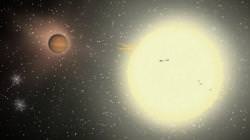An international team of astronomers announced today that they have discovered the largest extrasolar planet; it’s 70% larger than Jupiter. Amazingly, this new planet, dubbed TrES-4 is actually less massive than Jupiter. With the large size, and lower mass, the planet has a low density. You might call it fluffy.
The discovery of TrES-4 was made by astronomers working with the Trans-atlantic Exoplanet Survey. This is network of small automated telescopes in Arizona, California, and the Canary Islands designed to carefully measure the amount of light coming from stars. A periodic dimming and brightening is a candidate for a transiting planet, changing the light from its star as it moves by.
TrES-4 has a density of 0.2 grams per cubic centimetre. That works out to be less than the density of balsa wood. It would easily float in water if you had a large enough pool.
The planet is located about 1,400 light-years away, and orbits its host star in 3.5 days. This puts it into the hot Jupiter classification, orbiting only 7.2 million km (4.5 million miles) from its star, and reaching a temperature of 1,600 Kelvin (2,300 degrees F).
How did a planet with so little mass get so large? Good question.
“TrES-4 appears to be something of a theoretical problem,â€? said Edward Dunham, Lowell Observatory Instrument Scientist. “It is larger relative to its mass than current models of superheated giant planets can presently explain. Problems are good, though, since we learn new things by solving them.”
To capture transiting planets, the network of telescopes take wide-field timed exposures of clear skies on as many nights as possible. Astronomers then measure the amount of light coming from every single star in the field to detect if any have changed in brightness. In the case of TrES-4, it dims the amount of light received by the star by about 1%. It’s not a lot, but the telescopes and observing techniques can tease the data out.
Once the astronomers had a candidate discovered with the TrES network, they switched from the 10-cm telescopes they were using to the powerful 10-metre W.M. Keck telescopes atop Mauna Kea, Hawaii. They also made follow up observations with the Lowell Observatory and Fred L. Whipple Observatory in Arizona.
Original Source:Lowell Observatory News Release

